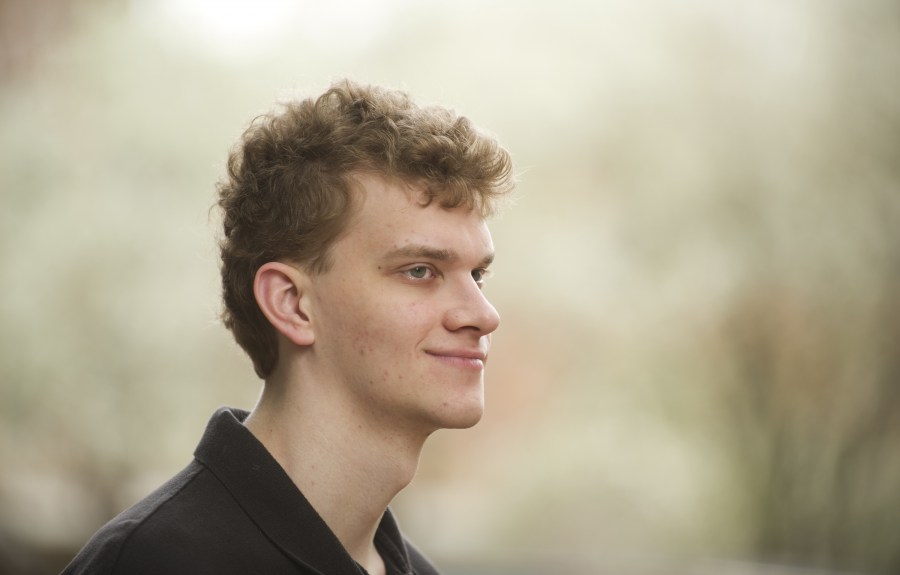
A new technology helped surgeons at Vanderbilt correct Nathan Cutright’s under bite, which helped improve his speech. (photo by Joe Howell)
Surgery’s success gives new shape to patient’s jaw, life
Nathan Cutright wasn’t supposed to be 6 feet 5 inches tall, but he grew so much during the summer between eighth and ninth grade — shooting from 5 feet 8 inches to 6 feet 3 inches — that his legs caused him a lot of pain.
And while his legs were growing, his jaw was growing too, forming a long “under bite” that not only dramatically affected his speech and appearance but also was potentially dangerous to his health.
Cutright, who also has attention deficit disorder (ADD) and Asperger’s syndrome, underwent corrective jaw surgery at Vanderbilt in September, 2011. The surgery involved moving his bottom jaw back 2 millimeters and his top jaw forward 7 millimeters.
To eliminate any guesswork in the operating room, Cutright’s surgeon Sam McKenna, DDS, M.D., chair of the Department of Oral and Maxillofacial Surgery, used a new technology known as virtual surgical planning to see the expected results and pinpoint measurements on the computer while planning the surgery.
“Virtual surgical simulation is taking surgical planning to the next level, where complex spatial changes can be simulated, visualized and verified by the surgical team and patient before we go to the operating room,” McKenna said.
“We not only have more control over desired surgical changes but also a better idea of what our results are going to be. And we are able to share this with the patient beforehand, and then actually go to the operating room and achieve the planned changes.”
McKenna said his patients are typically teenagers and young adults age 16 to 20 who have acquired facial deformities.
“Kids are very self-conscious of facial deformity,” McKenna said. “As teens, they don’t feel like they fit in. They are very motivated young people with deformities that impact both function and appearance so, by correcting that deformity, we are able to restore both function and self-esteem.”
Nathan’s father, Ed Cutright, said he is very pleased with the end result.
“Initially I was concerned that the physical effect of the surgery would be very difficult for him, a lot harder than it ended up being,” he said. “If we didn’t do anything it would only compound the issues that he faces in life anyway.”
“Seeing the end result, and the change in his ability to communicate, has just been astounding. It was pretty dramatic in the fact that they didn’t do any exterior cutting at all. And that they could plan it out virtually and visually and get it to match up within a half millimeter is amazing.”
McKenna said he primarily uses the virtual surgical planning when preparing for corrective jaw surgeries and other oral and maxillofacial surgeries that require pinpoint measurements.
“Certainly, prior to virtual surgical planning, you couldn’t manipulate the facial bones in a virtual manner and actually see how things fit together,” he said.
“It gives us more control over where we are placing various parts of the facial skeleton in space, a better idea of what the outcome is going to be, and we are learning ahead of time whether the planned surgical changes are technically feasible.”
Nathan Cutright said what he remembers best about the procedure, and having his jaw wired shut for a couple of weeks, is that “when you sneeze it hurts! And I sneeze at least five times a day.”
He notices the little differences here and there in both his appearance and his speech. His bite was also dramatically improved.
“It was something that I wanted to fix but a lot of me was saying, ‘Oh, I’ll just leave it for a while.’ And then when the jaw got fixed, I was like ‘Hmm.’ it was sort of the same until I looked sideways and I said ‘Oh wow I do have a difference,’” Nathan said.
“And when I talked before it sounded like I was saying something different than what I was actually saying,” he added.
Now he is focusing on going back to school to pursue his dream of becoming a pastry chef, a pursuit made a bit easier by the corrective procedure.
“It has just been amazing,” Nathan’s father said. “Knowing the end result, without question, I would not hesitate to tell anyone about our experience.”













